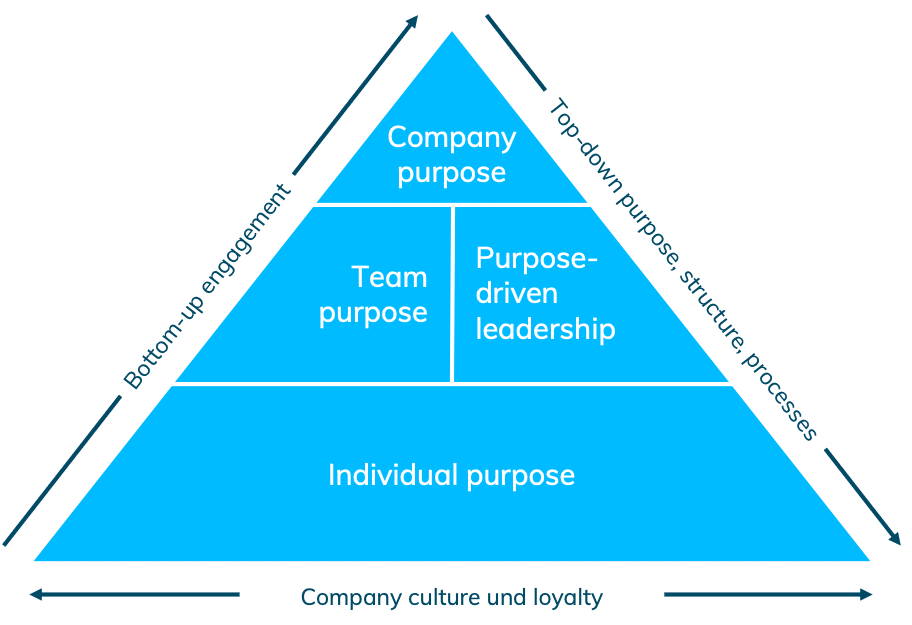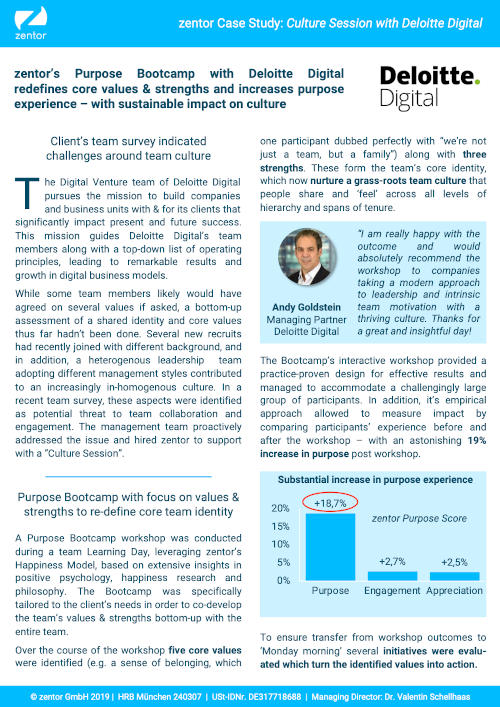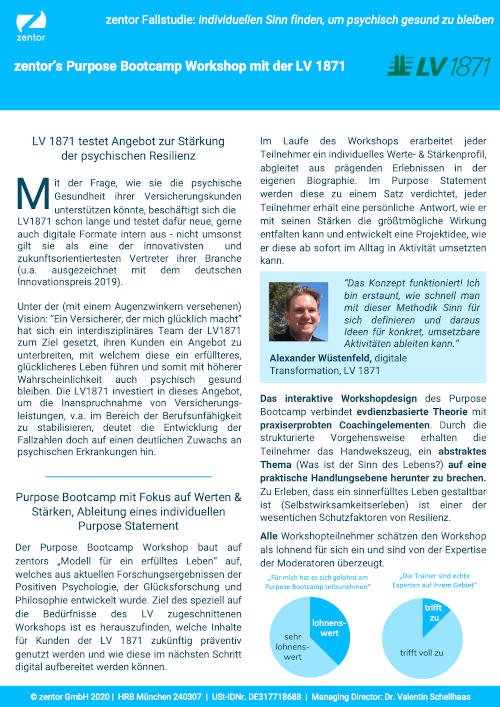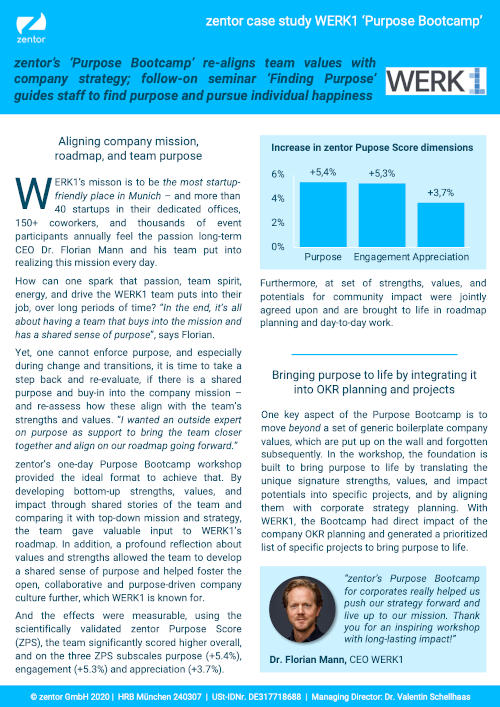How a common understanding of values, strengths and team purpose can strengthen the corporate culture and foster collaboration
It’s a matter of expectations
Employees are highly motivated at work, the atmosphere is productive and open, teams organize themselves independently, work together effectively and find productive solutions on their own. And then the alarm clock usually rings … Is this dream of almost every entrepreneur a realistic one? From my own experience as a manager and workshop coach for Purpose Bootcamps, my answer is “yes”. But that has perhaps even more to do with a certain image of humankind … and with a classic phenomenon. But let’s take it one step at a time.
At the risk of sounding naive: I am convinced that most people at the core try to do good and not harm others – in private as well as at work. As social beings, we need the benevolence of others, and our self-esteem depends on whether our behavior reflects our real self, i.e. whether we can look at ourselves in the mirror with a clear conscience. This is not to say that most people are incapable of evil or that there are no dangerous pathological cases such as narcissism or psychopathy. The emphasis is on “most” and “at the core try”. Many tries are made harder through negative experiences in the past or fail because of the environment – if you disagree, have a conversation with a therapist.
And while we are talking about the environment: Imagine someone gives you the feeling that you cannot be trusted in your work, constantly controls your tasks, disapproves of unsolicited initiative and punishes unforeseen mistakes. And then imagine someone else, who shows you the purpose and goal of the company and then gives you free reign to use the strengths of your team to find new creative solutions, helps you learn from mistakes and overcome hurdles. For whom would you engage more in your work? Your answer describes the phenomenon of self-fulfilling prophecy, or a sub-form of it, the so-called Pygmalion effect: If a teacher or supervisor suspects potential in a student or employee, this potential is also more likely to develop. And despite criticism of the original study, there is enough evidence that the expectations we have of others influence their performance and success.
Of course, not all employees are always motivated and sometimes a team member doesn’t fit into the team. And of course there are phases of a company in which a clear directive from above is necessary and authoritative decisions have to be made. And of course fear and punishment also act as motivators. But there are better alternatives. And more and more managers are recognizing the need to adapt the concept of work and collaboration under the term #NewWork to the changing requirements of society.
Meaningful approaches
It is not just about the great shift from a hierarchical, authoritarian organization with a strict division of labor to a modern organization, cooperation and leadership. Many small changes, a lack of innovation or even company mergers, economic crises and pandemics present companies with new challenges that can rarely be solved “top-down”. A holistic approach is required that takes into account all levels of a ‘purpose-driven organization’ (more details here ).

Why purpose? Well, a common assumption is that people who follow their ‘passion’ with their job also show the highest effort and performance – or to translate it into the language of our zentor model for a fulfilling life: People who aim at ‘engagement’ as a source of happiness. Morten Hansen from UC Berkeley once examined this assumption in a study with 5,000 participants. Indeed, those who follow their passion (engagement) with work have shown higher job performance than those who do not. However, those who realize high purpose in their work wereeven more productive than those who felt engaged/passionate (the highest level was shown when both were recognizable: purpose and engagement).
Employees who realize a purpose in their work perform even better than those who’ve ‘only’ turned their passion into their job.
The key
Fostering team cooperation requires a purpose-driven leadership, a jointly developed team values and and understanding which strengths can be used for which goal (and purpose). Only few executives intuitively show a ‘purpose-driven leadership’, especially if they are still unclear what role their own purpose plays in this (how to find purpose, we elaborate here). But even if the leadership succeeds, a team needs a common basis for long-term effective cooperation. A very essential part of it are shared values that go beyond empty phrases, which really enable to form an identity. A tip we always give in our Purpose Bootcamps for this is: If nobody will contradict, values are not formulated ‘sharp’ enough. Of course, these values must not contradict the corporate values, but should nevertheless serve as a kind of independent guardrail for the team. Even more important than values, however, is a good understanding of thesignature strengths of the team , and to which effect they can be used. The strengths are usually more difficult to recognize, but can usually be derived from formative team moments in the past. Last but not least, a team purpose that is experienced together is required, i.e. a task, goal or why that gives the team’s work a deeper meaning. In our workshops, we work with the teams to develop an initial purpose statement draft that incorporates current tasks and projects as far as possible and that relates to the company purpose.
The key to a successful team is shared values and the effective use of team strengths for a meaningful task.
All these approaches can be combined well in a 1-2 day workshop using proven methods from coaching practice and scientific findings from happiness research, and can be used effectively for a wide variety of applications.
Here are a few examples of how our ‘Purpose Bootcamp’ was used in different companies (each with a link to the case study):
At Deloitte Digital core values and strengths were realigned and current projects were evaluated to determine how they contribute to an experience of purpose. The aim was to promote a modern leadership approach with intrinsic team motivation.
After the merger of mydays with Jochen Schweizer, high potential employees from both organizations were – as part of a management trainee program – guided in their search for individual purpos. The aim was to promote a common corporate culture and purpose-driven leadership.
The insurer LV1871 used our Purpose Bootcamp as an employee benefit to strengthen mental resilience for employees and as a pilot program for a product expansion to insurance customers.
At Werk1 team values, strengths and purpose were put into perspective to the company purpose, with results from this finding their way into strategy and OKR planning. In a follow-up seminar, participants were additionally guided in their search for individual purpose.
No blind flying
One challenge with such abstract topics as ‘corporate culture’ or ‘purpose’ is always the question of when an intervention becomes necessary and how the success of an intervention can be measured. Especially in times of home office, remote work and decentralized teams, it is becoming increasingly difficult to recognize the current mood, corporate culture and the sense of purpose of employees. Many companies already use pulse checks or other proven tools for measuring corporate culture. Unfortunately, there are hardly any standardized measurement methods for purpose or the overarching concept of as fulfilling life. As a result, we’ve developed our proporietary zentorPurpose Score (ZPS) and scientifically validated it as a survey, which provides information about the purpose experience and the development over time (among other things).
Of course, we measure the ZPS in our purpose bootcamps, seminars and online courses and use this to track success and continuously improve our intervention methods.
If you are interested in a non-binding conversation about our Purpose Bootcamps, please call us on 089/32405287 or write to us on purpose[at] zentor.me
Sources and further reading
- Hansen, M. (2018). Great at work: How top performers work less and achieve more . New York: Simon & Schuster.
- Jussim, L. (2017). Précis of Social Perception and Social Reality: Why accuracy dominates bias and self-fulfilling prophecy. Behavioral and Brain Sciences , 40 . https://doi.org/10.1017/S0140525X1500062X
- Livingston, JS (1988). Pygmalion in Management Harvard Business Review. Retrieved from https://studydaddy.com/attachment/36551/nzpyqfkxkp.pdf
- Thorndike, RL, Rosenthal, R., & Jacobson, L. (1968). Pygmalion in the classroom. American Educational Research Journal , 5 (4), 708. https://doi.org/10.2307/1162010
- https://de.wikipedia.org/wiki/Pygmalion-Effekt




